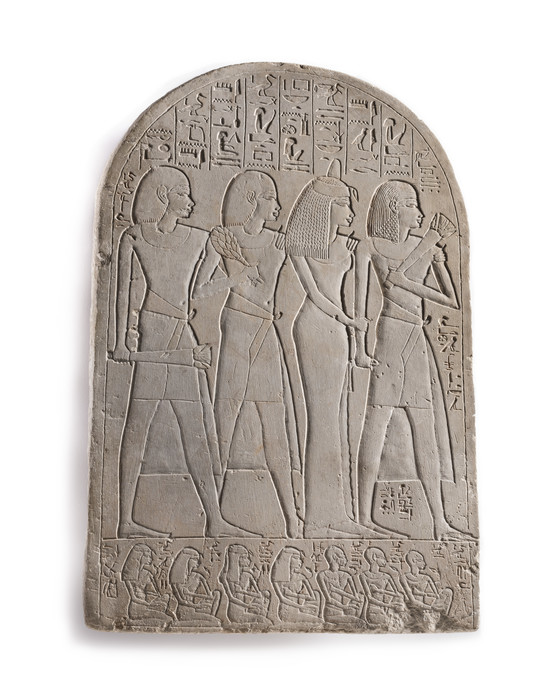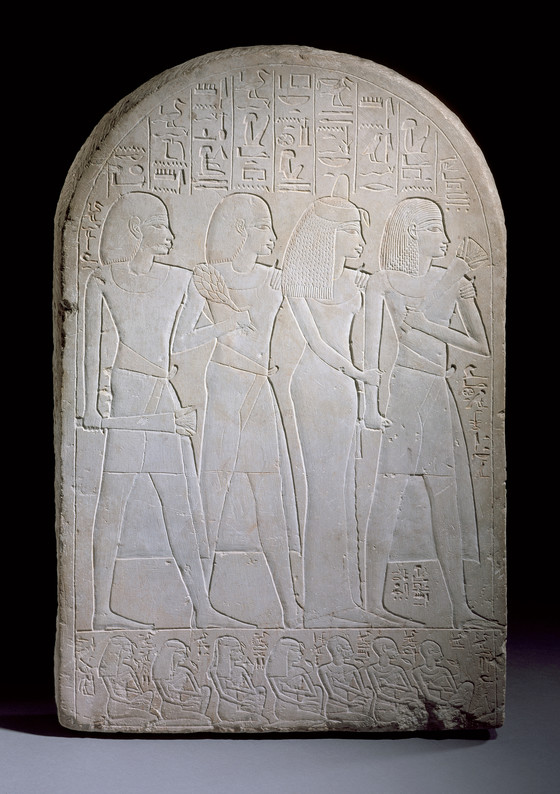This stela, a flat slab of stone with a commemorative purpose, was created for Iuef-er-bak, who is depicted by the figure on the right and identified by the hieroglyphs at the top....
This stela, a flat slab of stone with a commemorative purpose, was created for Iuef-er-bak, who is depicted by the figure on the right and identified by the hieroglyphs at the top. The stela was carved during the reign of King Amenhotep III in the middle of the Eighteenth Dynasty (1391-1353 B.C.). This stable and prosperous period is considered to represent the height of ancient Egyptian artistic production.
The stela was carved in sunk relief-the details are carved in recessed or sunken areas in varying levels of relief. The quality of the carving on this stela is exceptional for its attention to detail and its graceful contours. Notice the attention the artist gave to the facial features. The most important figures and details received the deepest carving. Originally, the entire surface of the stela was painted; now, only traces of pigment remain.
Iuef-er-bak, a noble from the capital city of Thebes, is identified by the hieroglyphs as "guardian of the store-house of the Temple of Amun." His wife, Nebet-iunet, and two sons accompany him. Iuef-er-bak and his sons carry floral funerary offerings. These four figures are examples of the standard representation of figures among ancient Egyptian artists: the eyes and shoulders are shown frontally and the head and lower body are shown in profile, which Egyptian artists believed was the best way to provide a comprehensive view of the human body. The woman stands with her feet together, and the men stand with their feet apart. All four figures have a youthful appearance. Egyptian artists indicated relative degrees of importance using scale; here, in the lower register, seven additional family members, who are noticeably smaller than the figures above, participate in a funerary banquet.
The stela was probably made for the necropolis (city of the dead) of Western Thebes, where it would have been placed in the tomb of the deceased. The ancient Egyptians believed that the afterlife was an actual physical existence that required sustenance, which the living provided through offerings. The deceased's ka, the aspect of a person that could be represented in artistic form, needed life-preserving goods such as food and drink. In the afterlife, an individual's ka dwelt within the mummy or the tomb statue.
Most stelae from this period were created to insure that the tomb owner would receive the offerings necessary to sustain him or her in the afterlife. This stela is unusual in that the text contains no direct request for funerary offerings, nor is there a depiction of the tomb owner and his family receiving offerings from a specific deity. The inclusion of the relatives and the biographical information on this stela may have served to ensure that family members and/or funerary priests would provide offerings forever. Representations of the deceased helped assure his or her survival. The name of the individual was also believed to be a vital aspect of the self that needed to be preserved.
More...





